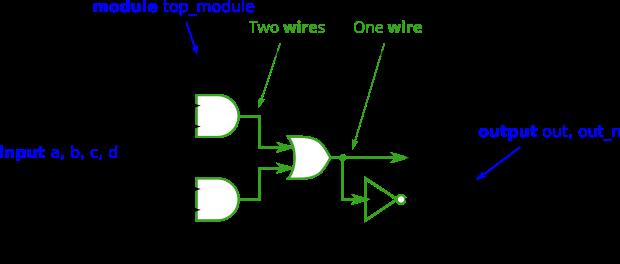verilog网站刷题记录
Posted 揭航
tags:
篇首语:本文由小常识网(cha138.com)小编为大家整理,主要介绍了verilog网站刷题记录相关的知识,希望对你有一定的参考价值。
verilog网站刷题记录
网站
题目
https://hdlbits.01xz.net/wiki/Wire
答案
Basic
simple wire(一根线)
Create a module with one input and one output that behaves like a wire.
module top_module( input in, output out );
assign out = in;
endmodule
four wires(四根线)
Create a module with 3 inputs and 4 outputs that behaves like wires that makes these connections:
a -> w
b -> x
b -> y
c -> z
module top_module(
input a,b,c,
output w,x,y,z );
assign w = a;
assign x = b, y = b;
assign z = c;
endmodule
Inverter(非门)
Create a module that implements a NOT gate.

module top_module( input in, output out );
assign out = ~in;
endmodule
Andgate(与门)
Create a module that implements an AND gate.
module top_module(
input a,
input b,
output out );
assign out = a & b;
endmodule
Norgate(或非)
或非门的坑!
要用! or
Create a module that implements a NOR gate. A NOR gate is an OR gate with its output inverted. A NOR function needs two operators when written in Verilog.
创建一个实现NOR门的模块。NOR门是输出倒置的或门。在Verilog中编写NOR函数时需要两个运算符。

module top_module(
input a,
input b,
output out );
assign out = ! (a | b);
endmodule
XNOR gate(同或)
Create a module that implements an XNOR gate.

module top_module(
input a,
input b,
output out );
assign out = a ~^ b;
endmodule
Declaring wires

`default_nettype none
module top_module(
input a,
input b,
input c,
input d,
output out,
output out_n );
wire a_b, c_d;
assign a_b = a & b; // 与
assign c_d = c & d;
assign out = a_b | c_d; // 或
assign out_n = !out; // 非
endmodule
选择器
Mux2to1(2选1)(1位)
Create a one-bit wide, 2-to-1 multiplexer. When sel=0, choose a. When sel=1, choose b.
module top_module(
input a, b, sel,
output out );
assign out = sel == 1 ? b : a;
endmodule
module top_module(a, b, sel,out);
input a, b;
input [3:0] sel;
output reg out;
// 有always 才有a b sel
always @(a, b, sel)
if (sel == 4'd1)
begin
out = b;
end
else
begin
out = a;
end
// assign out = sel == 1 ? b : a;
endmodule
Mux2to1v(100位)
Create a 100-bit wide, 2-to-1 multiplexer. When sel=0, choose a. When sel=1, choose b.
module top_module(
input [99:0] a, b,
input sel,
output [99:0] out );
assign out[99:0] = sel == 1 ? b[99:0] : a[99:0];
endmodule
Mux9to1v(9选1)
Create a 16-bit wide, 9-to-1 multiplexer. sel=0 chooses a, sel=1 chooses b, etc. For the unused cases (sel=9 to 15), set all output bits to '1'. // 后面这里说所有位都是1
module top_module(
input [15:0] a, b, c, d, e, f, g, h, i,
input [3:0] sel,
output [15:0] out );
always@(*)
begin
case (sel)
4'b0000: begin out = a; end
4'b0001: begin out = b; end
4'b0010: begin out = c; end
4'b0011: begin out = d; end
4'b0100: begin out = e; end
4'b0101: begin out = f; end
4'b0110: begin out = g; end
4'b0111: begin out = h; end
4'b1000: begin out = i; end
default begin out = 16'hffff; end
endcase
end
endmodule
Mux256to1
Create a 1-bit wide, 256-to-1 multiplexer. The 256 inputs are all packed into a single 256-bit input vector. sel=0 should select in[0], sel=1 selects bits in[1], sel=2 selects bits in[2], etc.
module top_module(
input [255:0] in,
input [7:0] sel,
output out );
assign out = in[sel];
endmodule
Mux256to1v
Create a 4-bit wide, 256-to-1 multiplexer. The 256 4-bit inputs are all packed into a single 1024-bit input vector. sel=0 should select bits in[3:0], sel=1 selects bits in[7:4], sel=2 selects bits in[11:8], etc
module top_module(
input [1023:0] in,
input [7:0] sel,
output [3:0] out );
// sel=1 selects bits in[7:4]
assign out = in[sel * 4 + 3], in[sel * 4 + 2], in[sel * 4 + 1], in[sel * 4];
endmodule
加法器
half_add半加器
Create a half adder. A half adder adds two bits (with no carry-in) and produces a sum and carry-out.
module top_module(
input a, b,
output cout, sum );
// cout 是 与
assign cout = a & b;
// sum 是异或
assign sum = a ^ b;
endmodule
full_add全加器
Create a full adder. A full adder adds three bits (including carry-in) and produces a sum and carry-out.
Sequential Logic
Shift Registers
Shift4
asynchronous是异步,synchronous是同步
Build a 4-bit shift register (right shift), with asynchronous reset, synchronous load, and enable.
areset: Resets shift register to zero.
load: Loads shift register with data[3:0] instead of shifting.
ena: Shift right (q[3] becomes zero, q[0] is shifted out and disappears).
q: The contents of the shift register.
If both the load and ena inputs are asserted (1), the load input has higher priority.
module top_module(
input clk,
input areset, // async active-high reset to zero
input load,
input ena,
input [3:0] data,
output reg [3:0] q);
always @ (posedge clk , posedge areset)
begin
if (areset)
q <= 4'd0;
else
begin
if (load)
q <= data;
else if (ena)
q <= q >> 1;
end
end
endmodule
Rotate100
Build a 100-bit left/right rotator, with synchronous load and left/right enable. A rotator shifts-in the shifted-out bit from the other end of the register, unlike a shifter that discards the shifted-out bit and shifts in a zero. If enabled, a rotator rotates the bits around and does not modify/discard them.
-
load: Loads shift register withdata[99:0]instead of rotating. -
-
ena[1:0]
- Chooses whether and which direction to rotate.
2'b01rotates right by one bit2'b10rotates left by one bit2'b00and2'b11do not rotate.
-
q: The contents of the rotator.
module top_module(
input clk,
input load,
input [1:0] ena,
input [99:0] data,
output reg [99:0] q);
always @(posedge clk)
begin
if (load)
q <= data;
else
begin
case (ena)
2'b01: q <= q[0], q[99:1]; // 右移
// 99 98 ... 1 0
2'b10: q <= q[98:0], q[99]; // 左移
default: q <= q;
endcase
end
end
endmodule
以上是关于verilog网站刷题记录的主要内容,如果未能解决你的问题,请参考以下文章